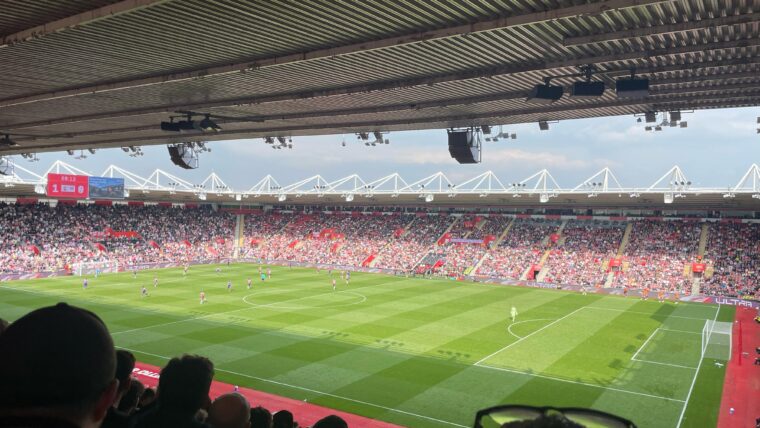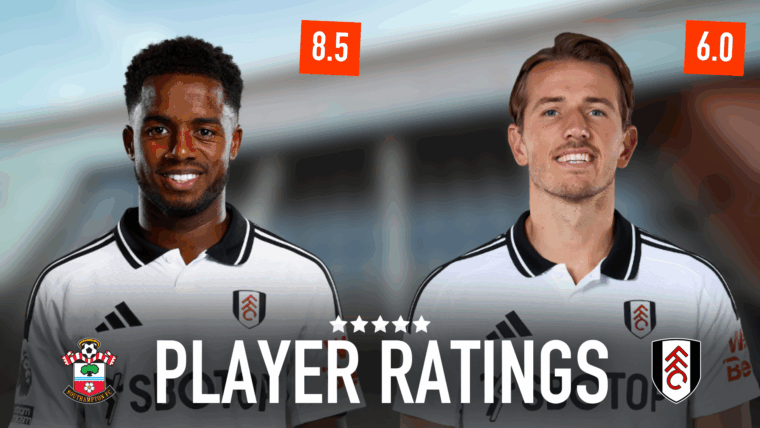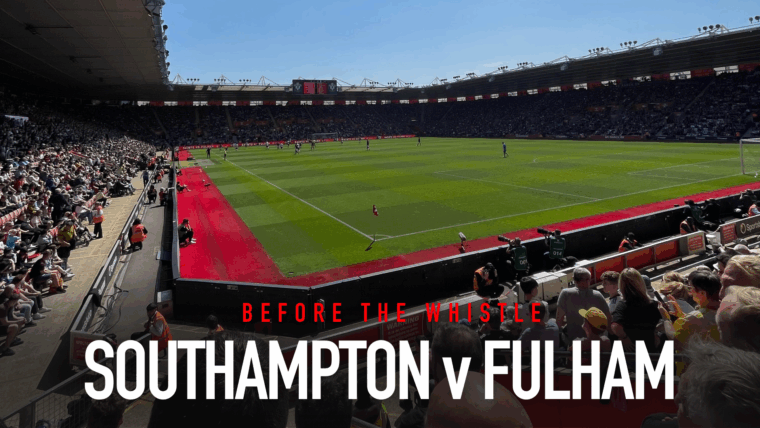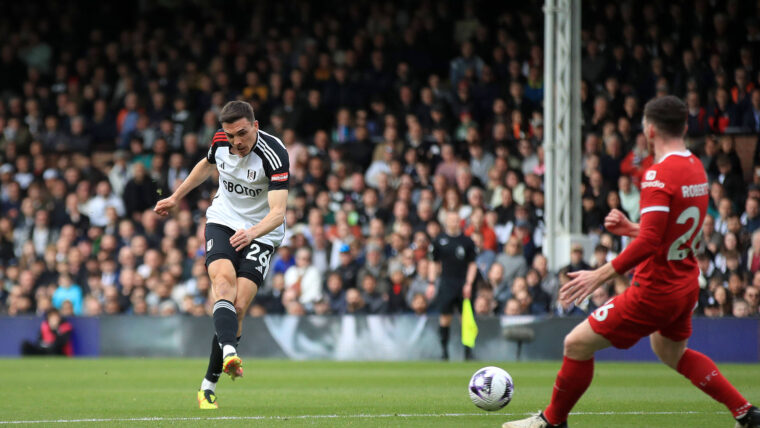Fred Callaghan: 1944-2022
Written by Michael Heatley on 14th September 2022
In tribute to a true Fulham legend, who passed away this week, we’re republishing Michael Heatley’s 2017 interview with Fred Callaghan.
‘The Tank’ proved one of Fulham’s finest defensive barriers
Cheering on a ‘Fred’ at full-back is nothing new if you’re a fan of a certain age. Barrel-chested Fred Callaghan was a regular on Fulham’s left flank for nearly a decade – and, what’s more, came from just down the road.
Born in Parsons Green and brought up in Roehampton, he describes his route to professional football in matter-of-fact terms. “I was a local lad who happened to be not too bad at football. I played schools football, progressing on to district football and then to London football. Then I got picked up by Fulham to go for a trial. I was accepted and invited onto the ground staff in 1960, when we had 15 apprentices.”
His colleagues were a gifted bunch indeed. “There was about eleven out of the 15 that made it… Stevie Earle, Rodney Marsh, John Dempsey, Leslie Barrett and Jimmy Conway. We had a fair array of talent.” When not playing, Fred’s duties as an apprentice had included “forking the pitch, sweeping the terraces, cleaning the seats, repainting the dressing rooms in the close season. Polish the players’ boots – you name it, I’ve done it!”
Callaghan was a wing-half (midfielder) in those early days before dropping back after a couple of seasons to replace the veteran Jim Langley. “There was a couple more in-between us, but no-one else was a regular in the left-back position.” While defence was the main priority, wing-backs having yet to be invented, Fred recalls “you could join in (the attack) when you wanted to.” He laughingly suggests fellow Roehampton boy Ryan Sessegnon “must have picked up a bit of information, a bit of skill from me!”
The man barking instructions in young Fred Callaghan’s ear on his March 1964 debut was player-turned-boss Bedford Jezzard. “We had a team manager and a general manager, Frank Osborne – not like nowadays where you get four or five people, a director of football, and so on.”
Fred’s decade in white saw Fulham endure two relegations and one promotion. “We were a bit up and down,” he admits, “similar to what we’ve been though over the last few years – always selling our best players in order to survive.”
There were plenty of highlights along the way. “Not only did I play with a couple of world-class players in Johnny Haynes and George Cohen, I played against some of the best players that have been on the planet – the likes of Eusebio, Pelé, Cruyff, George Best, Bobby Charlton… There was the Leeds team of Billy Bremner and Johnny Giles, the Liverpool team of Tommy Smith and Ian St John – there was an array of talent at all these clubs.”
Fred was known to fans as ‘The Tank’, but insists he was by no means a warrior. “I wasn’t dirty, I was just hard: I wouldn’t let people take any liberties with me, especially as a young lad of 17 getting into the first team and then at 18 and probably 19, when I was more of a regular. That was born from watching players like Roy Bentley, who was hard as anything, and people like Derek Lampe and Eddie Lowe. All these players didn’t take prisoners.”
There were, however, a couple of sendings-off, both occurring in games against north London teams. The first saw him take an early bath after sparring with Terry Venables at White Hart Lane in February 1967. “We managed to get ourselves sent off through pure aggression and wanting to win, really. As much as I used to love a tackle, certain other players used to love a tackle.”
The second, at the Cottage, was against Arsenal during a reserve game. “I was actually sent off when I wasn’t on the field of play! Charlie George and I were having a skirmish up the tunnel. We were both in the first team but trying to get fit after injury, and it can get a bit fiery when things aren’t going well. We had a clash at half-time and were asked not to come out for the second half!”
Goals, fortunately, outnumbered dismissals. “I scored about nine; probably the most important was in April 1972 when we were fighting relegation. I scored a header in the last minute at Charlton that saved us. We ended up with a 2-2 draw and if I hadn’t scored five minutes from the end we would have been relegated again.” What he doesn’t mention is that his strike sent the Addicks down to the third tier in our stead.
Fred Callaghan retired in 1974 after a slipped disc ended his near 300-game League career. “I got better once, came back and then did the injury again three weeks later. It’s not like the medical (facilities) we’ve got now, where they can dash you into hospital and do the operation straight away. It was a situation of seeing specialist after specialist. I went to Wolverhampton and saw the specialist who operated on Dave Watson and Joe Royle, but the chances were 50-50 that I’d end up not playing again.”
A spell at part-timers Enfield preceded a move into management with Woking. “We had a good run in the FA Cup. And then I went to Brentford and had a couple of seasons there. But it was the same situation as a lot of clubs now – with no money, we had to rely on local lads or players I knew.”
A couple of names in particular suggest Fred Callaghan was a shrewd judge of potential. “Terry Hurlock, a boy I signed from Leytonstone and Ilford for £15,000, went on and did very well for himself; he had a couple of big transfers to Southampton and Glasgow Rangers. Chris Kamara, now the pundit from Sky television, also did very well for me. All in all it was fairly successful, I spotted a bit of talent.”
But his Griffin Park management spell came to an abrupt end in 1984. “It was a bit unfortunate – we could win away from home but we couldn’t win at home (laughs). I enjoyed my couple of years there, it was good experience.”
Finding it hard to get back into football, Fred changed direction and became a London cabbie – a role that continues today. “When I finished playing a mate of mine was doing the Knowledge. I’d been on a couple of coaching courses but I was just messing around in the day, teaching football to boys in schools. So I decided to do the Knowledge with him.”
Callaghan enjoyed his recent role as a matchday host in the Legends lounges on the Riverside and still comes every week to support the team. On one occasion last season, when he brought the cab with him, he was flagged down on Putney Bridge by a mature gentleman and his daughter. “They said to me could you please take us to Worcester Park. I said of course, it’s on my way home. I live in Esher, I’ll drop you off.
“He asked how much it would cost and I said £25. Better still, I said, I used to play for Fulham. If you can tell who I am you get the fare for nothing! We got all the way to Worcester Park and were sitting outside his house. He’d had about 50 goes and couldn’t guess who I was until I took my glasses and hat off. He said I know who you are now. And I said as you’re a good Fulham supporter, that’s on the house…”
Fred admires current left-backs, Sessegnon and Malone, and considers them both worthy successors. “They look the part and I hope they carry on. I’ve been impressed with both lads. In fact I’ve been impressed for the whole team for the past three months; we’ve made considerable progress, and it’s all down to the manager. They’re playing some of the best football I’ve seen at the Cottage for ages.”
Tank or taxi-driver, Fred Callaghan, 72 years young and a one-club pro, will always be a local hero.



